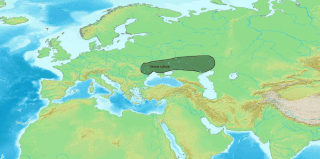 W
WThe Anatolian hypothesis, also known as the Anatolian theory or the sedentary farmer theory, first developed by British archaeologist Colin Renfrew in 1987, proposes that the dispersal of Proto-Indo-Europeans originated in Neolithic Anatolia. It is the main competitor to the Kurgan hypothesis, or steppe theory, which enjoys more academic favor.
 W
WA penumbral lunar eclipse took place on April 14, 1987. This subtle penumbral eclipse may have been visible to a skilled observer at maximum eclipse. 78% of the Moon's disc was partially shaded by the Earth, which caused a gentle shadow gradient across its disc at maximum; the eclipse as a whole lasted 3 hours and 54 minutes.
 W
WA penumbral lunar eclipse took place on October 7, 1987. The Moon approached within 1% of the Earth's umbral shadow at maximum eclipse; 99% of the Moon's disc was partially shaded by the Earth, with the overall eclipse lasting 4 hours and 14 minutes. While less dramatic than a partial eclipse, a shading across the Moon should have been readily visible to observers.
 W
WThe National Space Society (NSS) is an American international nonprofit 501(c)(3) educational and scientific organization specializing in space advocacy. It is a member of the Independent Charities of America and an annual participant in the Combined Federal Campaign. The society's vision is: "People living and working in thriving communities beyond the Earth, and the use of the vast resources of space for the dramatic betterment of humanity."
 W
WProject Longshot was a conceptual interstellar spacecraft design. It would have been an uncrewed probe, intended to fly to and enter orbit around Alpha Centauri B powered by nuclear pulse propulsion.
 W
WA total solar eclipse occurred at the Moon's ascending node of the orbit on March 29, 1987. It was a hybrid eclipse, with only a small portion of the central path as total, lasting a maximum of only 7.57 seconds. A solar eclipse occurs when the Moon passes between Earth and the Sun, thereby totally or partly obscuring the image of the Sun for a viewer on Earth. An annular solar eclipse occurs when the Moon's apparent diameter is smaller than the Sun's, blocking most of the Sun's light and causing the Sun to look like an annulus (ring). An annular eclipse appears as a partial eclipse over a region of the Earth thousands of kilometres wide. Totality of this eclipse was not visible on any land, while annularity was visible in southern Argentina, Gabon, Equatorial Guinea, Cameroon, Central African Republic, Sudan, Ethiopia, Djibouti and Somaliland.
 W
WAn annular solar eclipse occurred on September 23, 1987. A solar eclipse occurs when the Moon passes between Earth and the Sun, thereby totally or partly obscuring the image of the Sun for a viewer on Earth. An annular solar eclipse occurs when the Moon's apparent diameter is smaller than the Sun's, blocking most of the Sun's light and causing the Sun to look like an annulus (ring). An annular eclipse appears as a partial eclipse over a region of the Earth thousands of kilometres wide. Annularity was visible in the Soviet Union, China, southwestern Mongolia, Okinawa Islands of Japan except Kume Island and the southwestern tip of Kerama Islands, the Federal States of Micronesia, Papua New Guinea, Solomon Islands, Rotuma Islands of Fiji, Wallis Islands and West Samoa. Occurring only 5 days after apogee, the Moon's apparent diameter was relatively small.